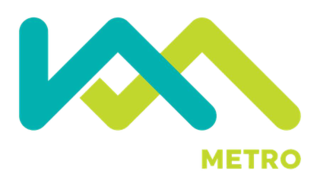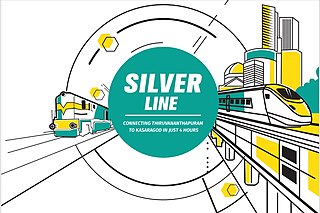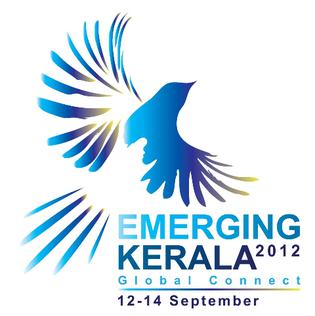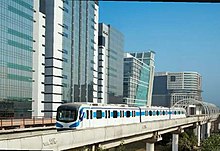
Thiruvananthapuram, formerly known as Trivandrum, is the capital of the Indian state of Kerala. It is the most populous city in Kerala with a population of 957,730 as of 2011. The encompassing urban agglomeration population is around 1.68 million. Located on the west coast of India near the extreme south of the mainland, Thiruvananthapuram is a major information technology hub in Kerala and contributes 55% of the state's software exports as of 2016. Referred to by Mahatma Gandhi as the "Evergreen city of India", the city is characterised by its undulating terrain of low coastal hills.

Oommen Chandy was the 10th chief minister of Kerala, serving from 2004 to 2006 and 2011 to 2016. He served also as the leader of the opposition in the Kerala Legislative Assembly from 2006 to 2011.
Thiruvananthapuram has long been a center of media. Kerala Chandrika, the first newspaper of the state, was published from Thiruvananthapuram in 1789. The media also enjoyed the patronage of the Travancore kings. In 1836, Swathi Thirunal, the Travancore king, organized a government press in the city. The first Superintendent of the Press was the Rev. Sperschneider. The press was under Samathanam Maistry, one of the first batch of workmen trained in the Nagercoil Press.

Thiruvananthapuram Central, or Trivandrum Central,, is a major railway station that serves the city of Thiruvananthapuram, capital of Kerala state, India. It is the busiest railway station in Kerala and an important rail hub in Southern Railway. The building of the railway station is one of the iconic landmarks of Thiruvananthapuram. The station is located at the center of the city opposite Central bus station Thiruvananthapuram at Thampanoor.

Delhi Metro Rail Corporation (DMRC) is a centre-state joint venture that operates the Delhi Metro and Noida Metro. The DMRC is also involved in the planning and implementation of metro rail, monorail, and high-speed rail projects in India and abroad. The work of DMRC is broadly fragmented into various parts which are controlled by the respective directors under the direction of a managing director.

Kerala State Road Transport Corporation (KSRTC) is a state-owned road transport corporation in the Indian state of Kerala. It is one of the country's oldest state-run public bus transport services. The corporation is divided into three zones, and its headquarters is in the state capital Thiruvananthapuram. Daily scheduled service has increased from 1,200,000 kilometres (750,000 mi) to 1,422,546 kilometres (883,929 mi), using 6,241 buses on 6,389 routes. The corporation transports an average of 3.145 million commuters per day.

Beaches in the Indian state of Kerala are spread along the 550-km Arabian Sea coastline. Kerala is an Indian state occupying the south-west corner of the subcontinent. The topography of the coastline is distinctive and changes abruptly as one proceeds from north to south. In the northern parts of Kerala, in places such as Bekal, Thalassery and Kannur, the headlands rise above the shore from the fringe of the beaches. The highlands are dotted with forts built by the colonial powers – the Portuguese, the Dutch and the British. The view of the surrounding area is mesmerizing. From Kozhikode, once the hub of the Malabar coast, the view changes to flat lands with rocky outcroppings jutting out. One feature is common all through – the coconut tree in large numbers. Dense groves of coconut trees line the coast and extend to the interiors.

The Kochi Metro is a rapid transit system serving the city of Kochi in Kerala, India. It was opened to the public within four years of starting construction, making it one of the fastest completed metro projects in India. The Kochi metro project is the first metro in the country which connects rail, road and water transport facilities. The first phase is being set up at an estimated cost of ₹51.81 billion (US$650 million). In October 2017, Kochi Metro was named the Best Urban Mobility Project in India by the Urban Development Ministry, as part of the Urban Mobility India (UMI) international conference hosted by the ministry every year. The Kochi Water Metro is integrated with the Kochi Metro, which serves as a feeder service to the suburbs along the rivers where transport accesibility is limited.

Technocity is a technology park an under construction integrated township in Trivandrum,India dedicated to electronics, software, and other information technology (IT). It was conceived in 2005 as the fourth phase of development of Technopark, Technocity is a complete IT City, spread across about 500 acres (200 hectares), which includes not just space for IT/ITES firms but also residential, commercial, hospitality, medical and educational facilities. The project is a new self-dependent satellite city, which would not strain the resources and infrastructure of the city of Thiruvananthapuram.

Thampanoor is the geographic center (CBD) of the Indian city of Thiruvananthapuram. The busiest railway station of the state in terms of daily passengers, Thiruvananthapuram Central, is located at Thampanoor. It caters an average of 40,908 passengers a day (2017–2018), making it as the busiest railway station in Kerala. Opposite to the railway station is the major Bus Terminal of Kerala, the Central Bus Station, Thiruvananthapuram (TVM) which is the largest and the busiest Bus station in the state connecting to almost all the parts of the State and other interstate cities. Thampanoor is administered by Thiruvananthapuram Corporation. Councillor of Thampanoor Corporation Ward is Harikumar. It falls under the Thiruvananthapuram which inturn comes under one of the seven assemblies under the Thiruvananthapuram.
Pappanamcode(Abode of Mahouts) is a locality of Thiruvananthapuram, the capital of Kerala, India. Only 5 km from Trivandrum central railway station and bus stand. It is one of the major industrial centres in Trivandrum.

The Thiruvananthapuram–Kasaragod Hill Highway or State Highway 59 (SH-59) is a proposed state highway in Kerala. Upon completion, it will be the longest highway in Kerala, extending from Nandarapadavu in Kasaragod district to Parassala in Thiruvananthapuram district, at a length of 1332.16 km. The highway will pass through 13 of the 14 districts, the exception being Alappuzha as that district is not part of the hilly ranges of Kerala.

Urban rail transit in India plays an important role in intracity transportation in the major cities which are highly populated. It consists of rapid transit, suburban rail, monorail and tram systems. According to a report published in 2021, a total of 2.63 billion people travelled annually in metro systems across India's fifteen major cities, placing the country as one of the busiest urban rapid transit hubs in the world in terms of ridership. The combined length of 871 kilometres of metro systems in India makes it the fourth longest in operation in the world.

Central bus station, also called Thampanoor bus station, is a bus station in Thiruvananthapuram, Kerala, India. It is located opposite the Trivandrum Central railway station at Thampanoor. It is the largest and busiest bus terminal in Kerala with 7.41 acres serving the buses traveling on all routes in Kerala and other inter-state destinations such as Chennai, Bangalore, Mysore, Nagercoil, and Kanyakumari. It is also the headquarters of the Kerala State Road Transport Corporation (KSRTC). A High-tech terminal complex was constructed by Harrisons Malayalam Limited Engineering Department, a Kerala-based construction contracting company.

Kozhikode Light Metro is a proposed Light Metro system for the city of Kozhikode (Calicut), in India. In 2010, the State government explored the possibility of implementing a metro rail project for Kozhikode city and its suburbs. The proposal was to have a corridor connecting Meenchanda to the Kozhikode Medical College Hospital through the heart of the city. An inception report was submitted by a Bangalore-based consultant, Wilber Smith, on the detailed feasibility study on the prospect of implementing the Mass Rapid Transport System (MRTS) and Light Rail Transit System (LRTS) in the city. However, the project has been scrapped to be replaced by Kozhikode Monorail project.

The Silver Line is a proposed higher-speed rail line in India that would connect Thiruvananthapuram, the capital city, and Kasaragod of Kerala state. It will have an operating speed of 200 kilometres per hour (120 mph), [Maximum Design Speed: 220 kmph, ] allowing trains to cover the 532-kilometre (331 mi) distance in less than four hours, compared to the present 10 to 12 hours it takes to traverse this distance. Thiruvananthapuram, Kollam, Chengannur, Kottayam, Kochi, Thrissur, Tirur, Kozhikode, Kannur and Kasaragod will be the stations in this corridor. The project is temporarily halted by the state government till the Central government approval.

Emerging Kerala is the name given to a biennial investors summit held by the Government of Kerala in Kerala, India. The event is aimed at bringing together business leaders, investors, corporations, thought leaders, policy and opinion makers; the summit is advertised as a platform to understand and explore business chances in the State of Kerala.

Kerala Rapid Transit Corporation Limited, abbreviated to KRTCL, is a special purpose vehicle (SPV) formed to implement light metro projects in Kerala. Kerala has light metro systems planned for the cities of Kozhikode and Thiruvananthapuram. The SPV is fully owned by the State Government and the Chief Minister is the Chairman of the company. The head office of KRTCL is at Thiruvananthapuram, with branches at Kozhikode and Thiruvananthapuram. Earlier it was Kerala Monorail Corporation Ltd. Since monorail was not financially viable, DMRC proposed light metro.
National Highway 66, commonly referred to as NH 66, is a mostly 4 lane 1,608 km (999 mi) long busy National Highway that runs roughly north–south along the western coast of India, parallel to the Western Ghats. It connects Panvel to Cape Comorin (Kanyakumari), passing through the states of Maharashtra, Goa, Karnataka, Kerala and Tamil Nadu.
Kozhikode district has an extensive network of road, rail and air travel services. Kozhikode city is the epicenter of the district. Vatakara and Thamarassery are other transport hubs.
















